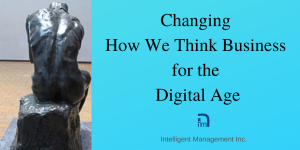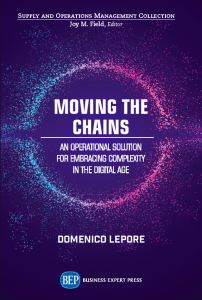
We were recently asked an important question following an article of ours about the dangers of linear thinking: “I can see how organizations could get stuck in one way of thinking as it often happens. How can organizations avoid being linear while forming their strategic plan?”
At Intelligent Management we take a systemic view of any organization and everything that goes on inside it. Strategy is connected with how the organization thinks about everything. So in reply to this valuable question, we always encourage organizations to use the Core Conflict Thinking Process to build a systemic strategy. Using the Thinking Processes helps individuals and the collective to reinforce their ability to think and act not in a limited, linear way but systemically.
The following adapted excerpt from Moving the Chains by our Founder, Dr. Domenico Lepore, takes on the very real problem of changing the way we think for the digital age.
Changing How We Think Business
Every single thing that happens in a company, from how strategy is designed to how a widget or a software is made and sold, is the end result of one specific human activity: thinking. In many companies, the thinking that originates the actions that follow is, at best, vague. Anyone who has sat in enough meetings knows this.
Why is so much thinking in organizations vague? It’s not because people lack intelligence or qualifications. The fact is that the kind of thinking that can produce high-quality results at a systemic level needs to be learned, but who is teaching it?
Dr. Eliyahu Goldratt declared that his mission was to “teach the world to think.” At Intelligent Management, we have had the privilege of sharing the Thinking Processes developed by Goldratt with dozens of companies over the years. What is perhaps most exciting is to see how these Thinking Processes raise the collective intelligence in any organization. They allow people to achieve real focus together, as a group, and then to act on that focus in an orderly and effective way. Not only does this work raise collective intelligence, it also leverages the unique intelligence, knowledge, and experience of the group to create breakthroughs and innovation where previously they were stuck.
The faster our world and our markets change through technology, the faster we must acquire systemic thinking skills to think through the shifts and innovations required to lead, adapt, or simply keep up. As we have said, the new covenant that everyone in the organization (as well as the value chain in which the organization is embedded) must embrace requires a much higher ability to think, communicate, and act; it requires a new “wiring” in the way we measure, manage, and sustainably improve our efforts toward our goals.
How Can We Boost Our Systemic Intelligence and Learn to Think Business in a Nonlinear Way?
Learning how to change is perhaps the greatest challenge businesses face and the most urgent one. Technology demands it and it may not be an exaggeration to say that perhaps our very survival as civilizations depends on it. In this sense, the conflict “Change vs. Don’t Change” that we saw in Chapter 8 is probably one of the most profound issues of our times. To fully embrace and leverage new technologies to our benefit, we need to learn to think systemically. However, this is not usually something that we are taught at school or in Business Schools. Indeed, thinking skills in general are not taught, beyond the ability to analyze something logically in terms of grammar or high-school math. Thinking, however, is never a purely logical activity. It is always informed by our emotions, our fears, and our desires. Above all, our thinking is “clouded” by our assumptions and the mental models we inevitably bring with us as part of how our brains have developed. These assumptions and mental models are intimately connected with our personal experiences and the environments where we learned to interact with the world. For example, if we ask an American, a Swede, and a Japanese person what they think about the right for civilians to bear arms, we will no doubt receive very different answers. It is perfectly understandable that people from different backgrounds have different world-views. However, when people need to interact to achieve a goal, these differing world-views often lead to conflicts.
The Creative Nature of Conflict
Thanks to the different world-views or assumptions about reality that various members of any organization or value chain bring to the table, conflict is inevitable. A conflict is a form of “constraint.” So far in this book, we have framed several situations or problems as “conflicts” following the approach developed by Dr. Goldratt. The Conflict Cloud is a powerful, structured, and highly effective way to leverage conflict as an opportunity for breakthrough and innovation. Indeed, conflict is an opportunity for creativity.
Why is this so powerful? Because no matter the conflict addressed, it takes into consideration for all parties the two fundamental human drivers: control (this connects with fear, restraint, stability, security, immanence, etc.) and vision (this connects with desire, expansion, satisfaction, transcendence, etc.). In any conflict, these two needs exist in a variety of manifestations, and any sustainable business solution must respect and protect them. This is key to achieving success through conflict.
SCHEDULE AN INTRODUCTORY CALL WITH US ‘






Leave a Reply